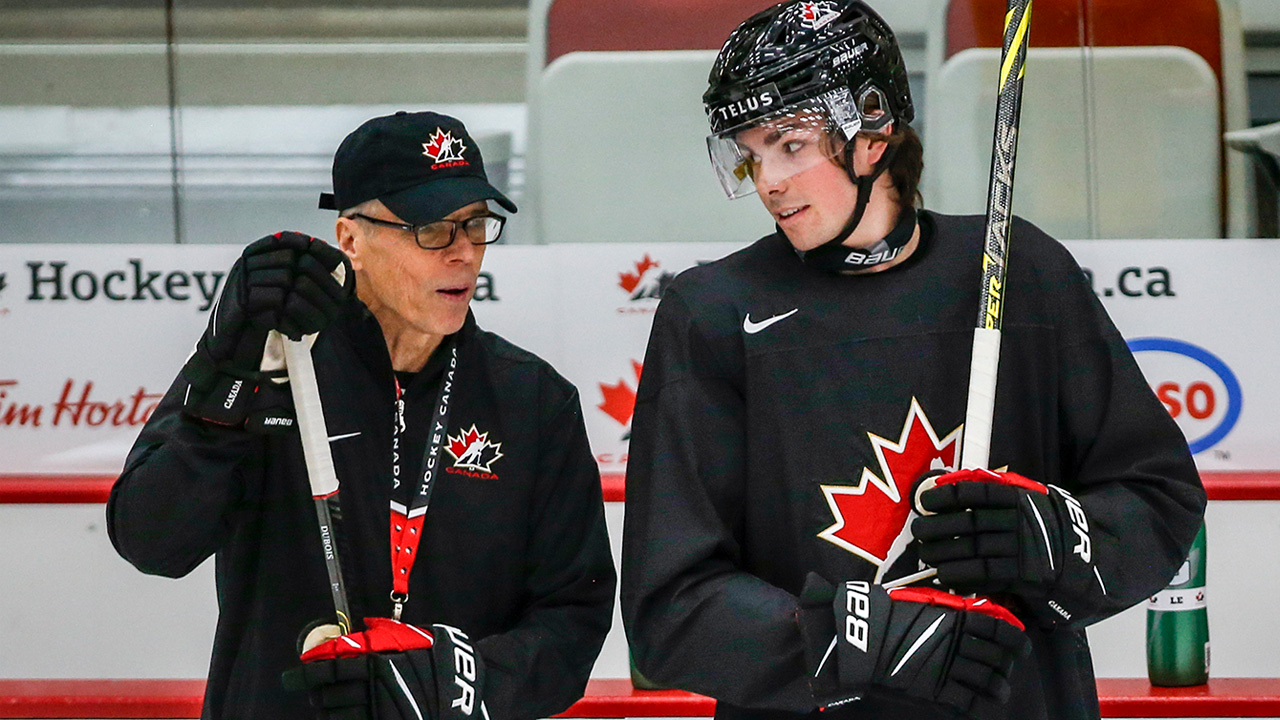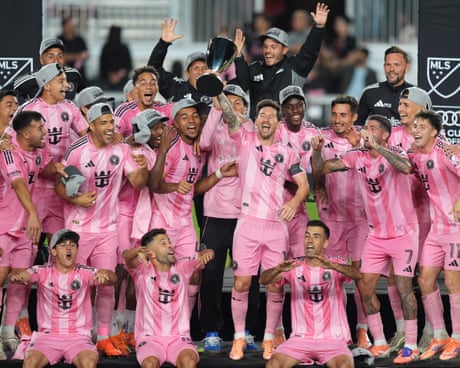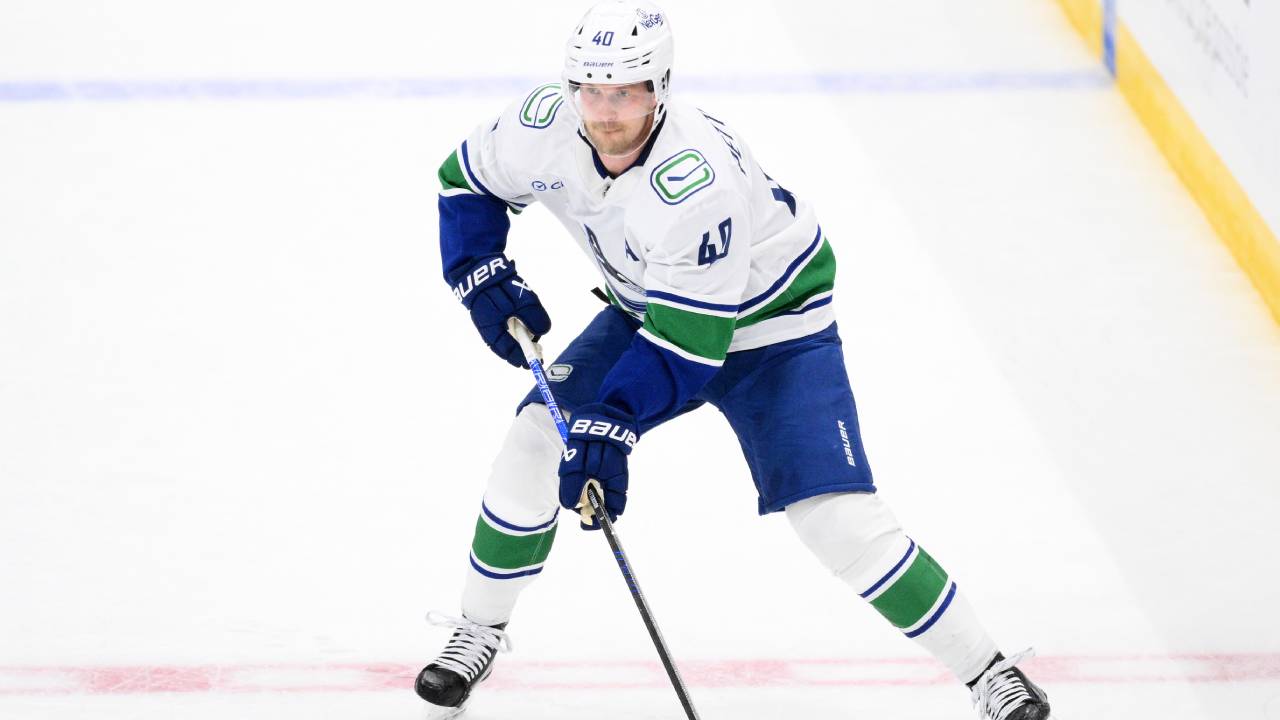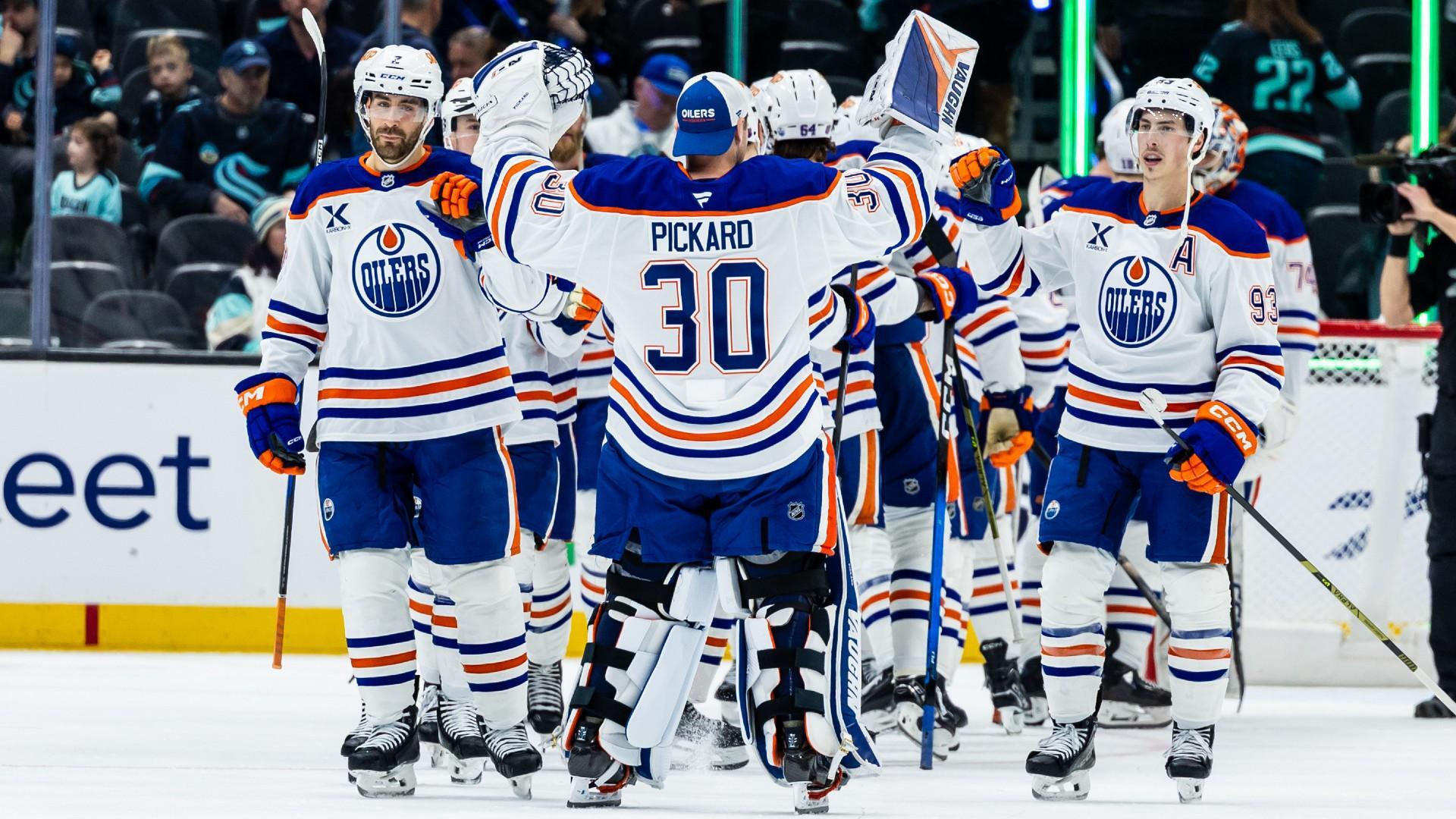
Canada will play host to the 2022 World Junior Hockey Championship for the second straight year, this time in both Edmonton and Red Deer.
This year’s tournament won’t be played in a ‘bubble’, so the threat of potential positive COVID-19 cases is even higher. Positive test results have already prevented several key players from being able to cross the border into Canada to play in the tournament, most notably Finland’s Aatu Raty and USA’s Thomas Bordeleau.
Always a medal contender at the World Juniors, Canada went undefeated last year up until the gold medal game. Only three players from that team will return this year, but make no mistake: Canada will be hungry to avenge 2021’s bitterly disappointing silver medal finish.
They will play in Edmonton with Austria, Czechia, Finland, and Germany. Austria managed to stay in the top division despite a tenth-place finish in 2021, as there was no relegation due to cancellations of other U20 tournaments last year.
With Austria and Germany both missing several star players, Canada and Finland should cruise easily through group play and on to the medal round. Though there’s no guaranteed win in any game at this tournament, there shouldn’t be much surprise with how Group A shakes out by the end of the round robin.
However, Group B is a different story, and upsets aren’t out of the question in this year’s ‘group of death’.
The United States enters the 2022 World Juniors as defending champions, but a path to back-to-back gold medals will be difficult.
Russia looms large in the round robin for a second straight year, and Sweden brings a strong squad to the 2022 tournament after their surprising quarter-final exit in 2021.
Slovakia will be no pushover in group play, bringing one of the country’s strongest teams in tournament history. Switzerland rounds out the five teams in Group B, but they’re always a tough opponent in the round robin.
There will be more parity at this year’s World Junior tournament, as there’s no clear-cut favourite to win gold. Canada is always a contender, but they face stiffer competition than in recent years. Here’s a look at how each country stacks up heading into the tournament.
GROUP A
Austria
2021 Finish: 10th
Strength: Goaltending
It seems odd to think of goaltending as Austria’s strength coming into the 2022 World Juniors, but Sebastian Wraneschitz will be back between the pipes. As ugly as some of those round robin games were for Austria last year, it could have been much worse without Wraneschitz, who will be remembered for his incredible 62-save performance against the United States. Austria will likely struggle once again preventing goals against, but Wraneschitz will provide stability and experience in net again this year.
(of 194) times @hockeyaustria‘s Sebastian Wraneschitz blew our minds. #WorldJuniors pic.twitter.com/dKj3zltxLe
— IIHF (@IIHFHockey) December 31, 2020
Weakness: Offensive Production
Austria was shutout in three of their four round robin games at last year’s tournament, and their lone goal was scored by Senna Peeters. But their offence takes an even bigger hit with Marco Rossi (MIN) too old to return this year, which means Austria will have to rely on Peeters again this year to provide most, if not all, of their offence. Although Austria plays in a weaker group this time around, they will have to find a way to produce more than the one goal they managed last year. It will likely be their New Year’s Eve showdown against Germany that determines whether they make it to the quarter-finals or play in relegation.
X-Factor: Marco Kasper (2022) & Vinzenz Rohrer (2022)
The Austrians have two intriguing draft-eligible players on their roster this year in Marco Kasper and Vinzenz Rohrer. Kasper is likely to be a top-64 pick at the NHL draft in July, and Rohrer, a childhood friend of Rossi’s, has been among the top-five OHL rookies in scoring all season. While underage players don’t typically have as large of an impact at the World Juniors, both players could provide Austria the edge needed to avoid relegation.
Canada
2021 Finish: 2nd
Strength: Offensive Skill
There’s no denying Canada left some younger skill off this roster in favour of older players, but the forward group is still strong, and Canada will contend for a gold medal. Cole Perfetti (WPG) is the lone returnee up front, but he’ll be joined by the likes of Mason McTavish (ANA), who could have stayed in the NHL this year, and likely 2022 first overall pick Shane Wright. Kent Johnson (CBJ), Dylan Guenther (ARI), Xavier Bourgault (EDM) and Elliot Desnoyers (PHI) will provide consistent depth scoring, and Canada should be able to roll four lines without much issue.
Weakness: Inexperienced Blue Line
Brandt Clarke’s (LAK) omission from Canada’s selection camp came as a shock to many, as Canada’s blue line was viewed as the team’s one weakness heading into this year’s tournament. Then Jack Thompson (TBL) was ruled out of camp due to COVID-19 protocols, and Vincent Iorio (WSH) didn’t make the final team, leaving Canada with no right-shot defenders on their roster. Kaiden Guhle (MTL) is the lone returning defenceman from 2021, and he will have to lead the blue line along with first overall pick Owen Power (BUF). Canada will rely on both heavily, but the inexperience on the back end could prevent them from winning gold this year.
X-Factor: Connor Bedard (2023)
Hockey fans should be excited to watch Connor Bedard this winter after he became the first 16-year-old to make Canada’s World Junior team since Connor McDavid. Bedard had an electrifying showing at the U18s last spring with 14 points in seven games, and after a six-point showing in two selection camp games, expectations are even higher now. Bedard is not expected to play the biggest role to start, but if he can continue to produce and hold his own against much older opponents, Bedard should be able to work his way into a top-six role. His dynamic, game-changing abilities should make him a key player as Canada attempts to redeem themselves from last year’s silver medal.
[radioclip id=5260878]Czechia
2021 Finish: 7th
Strength: Experience Up Front
They may have lost Michal Teply (CHI) and Martin Lang, but two of Czechia’s top three scorers from 2021 will return again in 2022. They will rely heavily on captain Jan Mysak (MTL), Pavel Novak (MIN) and Michal Gut to drive the offence again up front. Players like Ivan Ivan and Martin Rysavy (CLB) will provide a two-way presence and secondary scoring, but the Czechs will need offensive contributions from everyone in the lineup to advance beyond the quarter-finals this year.
Weakness: Uncertainty In Goal
Jan Bednar (DET) will likely get the starting job for Czechia, at least to start the tournament. The 19-year-old is the lone returning goalie from last year’s team, but he didn’t play in any games and he’s having a rough start to the season with Acadie-Bathurst in the QMJHL. They could also turn to 18-year-old Daniel Kral, who has experience representing his country at international tournaments and has decent numbers in the Czech U20 league so far this year. The Czechs will likely earn a quarter-final berth playing in an easier group this time around, but uncertainty between the pipes could prove to be their undoing in the medal round.
X-Factor: David Jiricek (2022)
Defenceman David Jiricek made his World Juniors debut as a 17-year-old last year, and he held his own with two points in five games. Jiricek comes into the 2022 tournament as one of three returning Czech blueliners, and the expected first rounder in 2022 will hopefully boost his NHL draft stock with a strong tournament. Jiricek will likely be paired with Stanislav Svozil (CBJ), and the two will be relied on to both shut down offences and produce from the back end.
Finland
2021 Finish: 3rd
Strength: Experience
Although 2021 leading scorer Anton Lundell (FLA) has aged out of the tournament, Finland still has 10 players returning for the 2022 World Juniors. Goalie Joel Blomqvist (PIT) didn’t get into any games last year, but he’ll likely take on the starting job this time around. Finland also has four returnees on the blue line, headlined by 2021’s top defenceman Topi Niemelä (TOR), who was second in team scoring with eight points in seven games. Up front, Kasper Simontaival (LAK) and Roni Hirvonen (TOR) are among five returning Finns who will lead the offensive charge this year.
Weakness: Lack Of Centre Depth
Finland’s forward group took a big hit when it was announced that Aatu Raty (NYI) would miss the tournament due to a positive COVID-19 test. Raty wasn’t part of Finland’s team last year, but he played on the 2020 team as a double underaged player. Raty’s absence means Finland has a big hole to fill down the middle. Hirvonen, who would have probably played on Raty’s wing, will shift to centre. Oliver Kapanen (MTL), Samuel Helenius (LAK) and Juuso Mäenpää are options Finland can deploy down the middle, but it remains their weakest position.
X-Factor: Joakim Kemell (2022)
Finland is fairly deep on the wings this year, and Joakim Kemell is a name to watch not just for the tournament, but for the upcoming NHL draft as well. Kemell is projected to go in the top five, and he could very well end up being the next best prospect after Shane Wright this year. An elite shoot-first winger, Kemell is having a strong season with JYP in the Finnish men’s league and will be relied on to help drive Finland’s offence at the 2022 World Juniors.
Germany
2021 Finish: 6th
Strength: Playing in Group A
Germany had a rough go of things last year, especially after playing their first two round-robin games with only 15 skaters. Still, they were able to make it to the quarter-finals and finish a respectable sixth place. Their one saving grace in 2022 is that they’re not playing in the loaded Group B this year, otherwise they might be headed for the relegation round just by default. Instead, Germany will likely only have to beat one of Austria or Czechia to make it back to the medal round, where anything can happen.
Weakness: Missing Stars
Germany will be without stars Tim Stützle (OTT) and J.J. Peterka (BUF), the two players who led the German charge in 2021. Though both are still eligible, the Ottawa Senators opted not to loan Stützle to the tournament, and both Peterka and Lukas Reichel (CHI), who missed the tournament last year with COVID-19, decided to stay with their respective AHL teams. Their absences are a tremendous blow to the German offence and to Germany’s chances at the tournament.
X-Factor: Florian Elias (undrafted)
Without Stützle, Peterka and Reichel, Germany’s offensive responsibilities likely fall solely on returnee Florian Elias, who had four goals and nine points in five games last year. It’s a tall task, as Elias produced mostly with Stützle and Peterka, and Germany doesn’t have offensive weapons of the same calibre to deploy him with this time. But if they hope to make it back to the quarter-finals, Germany will have to rely on Elias to get them there.
GROUP B
Russia
2021 Finish: 4th
Strength: Goaltending
Is third time the charm for Yaroslav Askarov? The Nashville Predators’ 11th overall pick in 2020 nearly led Russia to a gold medal at this tournament as a 17-year-old two years ago, and then fell just short of the podium last year. If Russia is to contend for gold and win a medal at the 2022 World Juniors, Askarov will be a big reason why.
Weakness: Blue Line
Russia opted to leave tournament-eligible players in North America off their team this time around, including Daniil Chayka (VGK) and Yan Kuznetsov (CGY), who played at the World Juniors last year. That leaves Shakir Mukhamadullin (NJD) and Kirill Kirsanov (LAK) as the lone returning defencemen from 2021. It would have been an underwhelming blue line even if Chayka and Kuznetsov had made the team. Without them, Mukhamadullin will have to take on the bulk of the defensive responsibilities. Vladimir Grudinin (2022) is a name to keep an eye on, but Russia’s blue line will have its work cut out for them facing difficult opponents in round robin play.
X-Factor: Matvei Michkov (2023)
There’s no denying that Matvei Michkov (2023 draft eligible) is the most talented player on the Russian roster this year. He had 12 goals and 16 points in seven games at the U18s this past spring as a double underaged player. Michkov became the youngest player in Russian history to play on the senior men’s national team a month ago at the Karjala Cup and celebrated that achievement by scoring a lacrosse goal in his debut game. Whether Russia gives him the ice time to make an impact and show what he’s capable of remains to be seen, but Michkov’s electrifying, game-breaking skill makes him a player to watch.
YOU’VE JUST BEEN MICHKOV’D
HE PULLS OFF ‘THE MICHIGAN’!!
Matvei Michkov #RUS
1-1 #KarjalaCup pic.twitter.com/13KuTfKy2V— This is the KHL (@KHLreplays) November 13, 2021
Slovakia
2021 Finish: 8th
Strength: Draft-Eligible Talent
This year’s team may be the strongest Slovakia has sent to the World Juniors in a long time. Martin Chromiak (LAK) will lead the charge again for Slovakia, but it’s their draft-eligible players who are expected to shine on the international stage. Forwards Filip Mesar, Juraj Slafkovsky, and Servac Petrovsky are all expected to play big roles for Slovakia. Defenceman Simon Nemec led the Slovaks in scoring at last year’s tournament as a double-underaged player and could be a top five NHL draft pick in July. And keep an eye on 16-year-old Dalibor Dvorsky, a likely first-rounder in 2023 who is off to a strong start in the Swedish J20 league.
Weakness: Playing in Group B
As strong as Slovakia’s team will be, it may not matter. It will still be extremely difficult for them to pull off an upset against any of the United States, Russia or Sweden. Slovakia’s most important game will be Dec. 30 against Switzerland — a win would likely advance them to the quarter-finals, but a loss could mean Slovakia fighting for their lives in the relegation round.
X-Factor: Simon Latkoczy (undrafted)
Slovakia will turn to Simon Latkoczy in goal again this year. Latkoczy was named one of Slovakia’s top three players in 2021, most notably due to his Boxing Day shutout over Switzerland, and posted a .922 save percentage through three games. If Slovakia wants to improve upon their eighth place finishes from the last three tournaments, Latkoczy will need to be on his A-game.
Sweden
2021 Finish: 5th
Strength: Goaltending
Sweden had an underwhelming 2021 tournament, and saw their round robin win streak finally snapped at 54 games. Jesper Wallstedt (MIN) wasn’t able to take the starting job away from Hugo Alnefelt (TBL) and run with it, leading to Sweden’s eventual early and shocking quarter-final exit. But Wallstedt will be back between the pipes this year, and the Minnesota Wild’s first round pick in 2021 is having a great season with Luleå in the SHL. Calle Clang (PIT), Sweden’s third goalie last year, will likely get the backup job this time.
Weakness: Replacing 2021’s Offence
While Lucas Raymond (DET) is still eligible to return to this year’s tournament, the 19-year-old is too busy racking up points in the NHL, which means Sweden will be without one of their better offensive weapons. Three other players were tied with Raymond for the scoring lead on Sweden last year with five points in five games, but none of them will return either. The offensive responsibilities will fall on Alexander Holtz, who was loaned by the New Jersey Devils, Fabian Lysell (BOS), William Eklund (SJS), Theodor Niederbach (DET) and Oskar Olausson (COL).
X-Factor: Simon Edvinsson (DET)
Emil Andrae (PHI) is the lone player who will return from Sweden’s deep 2021 defence corps, which means the blue line will be relatively inexperienced this time around. However, Detroit’s sixth overall pick in 2021, Simon Edvinsson, could help provide the necessary stability on the back end. The hulking 6-foot-5, 207-pound left-shot defender is a smooth-skating, physical player who has the ability to produce from the blue line as well.
Switzerland
2021 Finish: 9th
Strength: Returning Players
Eleven players will return from the 2021 Swiss team that underwhelmed and finished ninth, including seven forwards. The Swiss blue line will miss Inaki Baragano, but Giancarlo Chanton, Noah Delemont and Noah Meier should pick up the slack. Goalie Noah Patenaude played just one game last year and was lit up for 10 goals, but he will likely carry the workload between the pipes this time around. Although Switzerland looks bound for the relegation round again this year, the returning players should be motivated to fight for a different outcome.
Weakness: Lacking Offensive Catalysts
Switzerland may not have had as difficult a time scoring at last year’s tournament compared to Austria, but they still struggled mightily to generate offence. No player scored more than one goal and Dario Allenspach led the team with just three assists in four games. Those problems will likely persist for Switzerland again this time around, as they lack a dynamic offensive driver who can take on most of the production responsibilities. It will take a scoring-by-committee approach for the Swiss to make it out of group play this year.
X-Factor: Lorenzo Canonica (undrafted)
Lorenzo Canonica had just one assist at last year’s tournament, but he’s producing consistently in the QMJHL this season and had 27 points in 29 games with the Shawinigan Cataractes before leaving to join the national team. While the Swiss can’t rely on just one player this year to produce, hopefully Canonica will be able to carry his production over to the World Juniors and lead Switzerland offensively.
United States
2021 Finish: 1st
Strength: Deep Blue Line
The American blue line is incredibly deep this year, and they’ll be led by top five NHL draft picks Jake Sanderson (OTT) and Luke Hughes (NJD). Returnees Brock Faber (LAK) and Tyler Kleven (OTT) will bring experience, and Scott Morrow (CAR) has been a point-per-game player with UMass this season. Regardless of which players dress for each game, this year’s blue line is arguably stronger than last year’s and they’ll make things very difficult for opposing offences on every shift.
Weakness: Goaltending
Replacing Spencer Knight (FLA) this year won’t be an easy feat for the United States, and there isn’t a clear-cut starter among the three goalies they will bring. While Drew Commesso (CHI) has the inside track to the starting job, he’s had an up-and-down sophomore season with Boston University. Undrafted USHL goalie Kaidan Mbereko will likely earn back-up responsibilities, but there could be an outside chance for 17-year-old Dylan Silverstein (2022) to see some game action. Neither Commesso nor Mbereko have Knight’s ability to steal games, and with the United States in a difficult group this year, goaltending will impact their chances to repeat as World Junior champions.
X-Factor: Matty Beniers (SEA)
The United States will certainly miss all of Trevor Zegras (ANA), Cole Caufield (MTL), and Arthur Kaliyev (LAK), and their forward group is nowhere near as deep as it was last year. However, 2021 second overall pick Matty Beniers (SEA) will play a much larger role this time around. He’s one of just three forwards who will return from last year’s gold medal-winning squad, and Beniers is having another offensively prolific season with Michigan. Beniers’ near-complete game will make him one of the United States’ most important players as he leads the American offence into battle each game.





